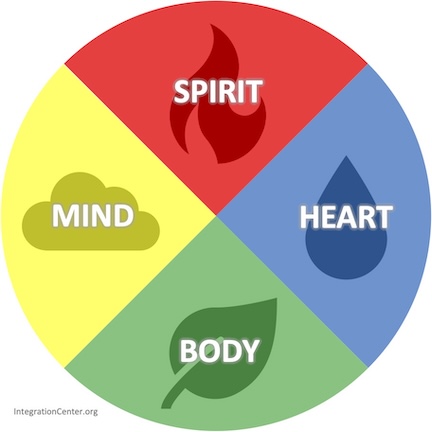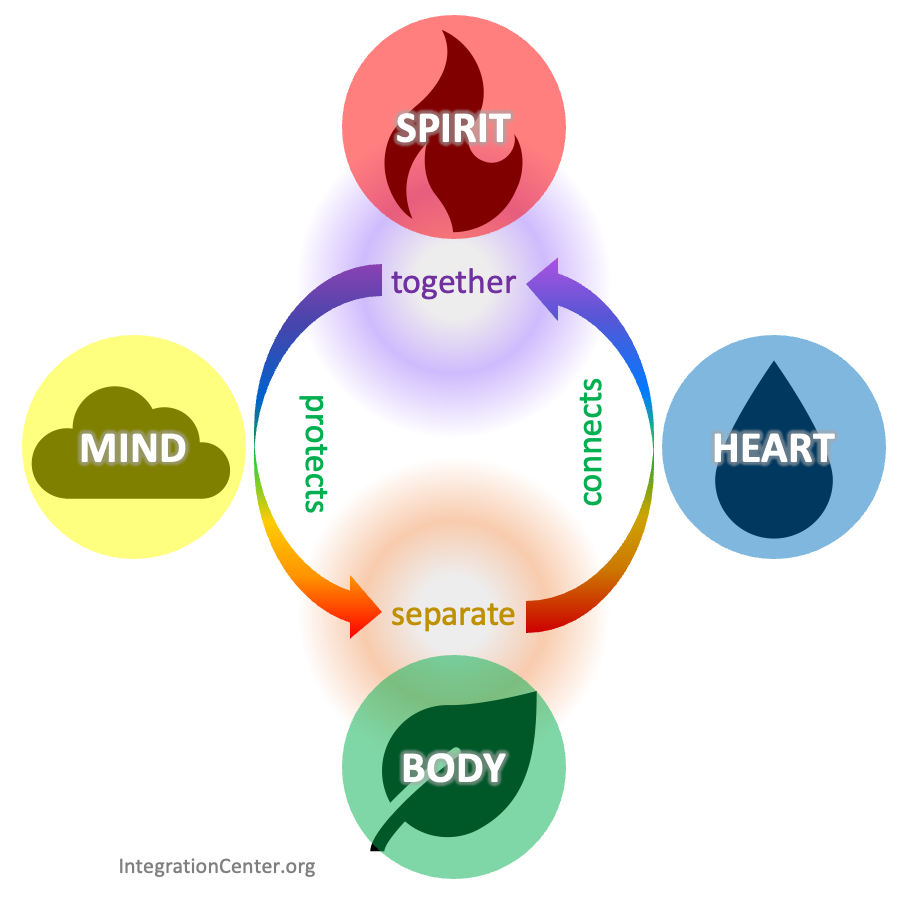Integration Centers use the four-part model of the human soul, originating in Andean traditions. This model (a version of “the shamanic wheel”) looks at humans from four different aspects: mind, body, heart, and spirit.

The body is the animal form in which we manifest. Messages from the body come in the form of feelings, most strongly as a “gut feeling.” Body pulls us in the opposite direction of spirit, which is our connection to the rest of the universe, to the unity of all things. Messages from spirit come in the form of intuition and inspiration.
The mind is the “in our head” stuff we use to analyze the world. Messages from the mind come in the form of thoughts and fears. Mind is opposite the heart which is both our connection to others and our passion for what we do. Messages from the heart come in the form of attraction, desires, and drive.
In a healthy system, mind and heart balance each other. Mind helps the heart to make plans to achieve the desires of the heart. When heart is over-weighted, a person may rush into situations without considering the consequences. When mind is over-weighted, the heart may be restrained by fear and anxiety.
Body and spirit are also a duality. Spirit is the unity of all things, while body is the singular animal, intent on self-preservation in the material world. A person who is over-weighted in spirit may neglect their health; while a person who is over-weighted body, in their singular self, may feel aimless and disconnected.
The shamanic wheel is especially helpful when looking at humans working toward a state of health. In our current unhealthy culture, people have afflictions in all parts of themselves and can benefit from a concerted approach using various modalities that reach to all four of those parts.
Healing in the Body
There are several kinds of physical afflictions. Both injuries and infectious diseases come from external factors, and conventional modern medicine is rather good at dealing with them.
Conventional medicine is less effective at dealing with neurological, immunological, and chronic disorders because most of them do not originate from external factors, but from internal stress on the body from emotional dysregulation, as explained in detail by Dr. Gabor Maté.
Apart from afflictions, many modern humans suffer physical duress from the conditions in which they live.
Osteopathic manipulation, acupuncture, and Rolfing are all helpful in realigning the body to a more optimal state. A body connection approach helps maintain the body in an optimal state. A regular yoga practice in a disciplined form such as Ashtanga can be extremely beneficial as well.
Healing in the Mind
Modern humans are heavily over-weighted in the mind, to the detriment of their body, heart, and spirit.
Anxiety disorders are afflictions that mostly run in the mind, but the roots of those afflictions often lie in the heart (in previous traumas).
The primary modern affliction of the mind is faulty belief structures. Many people are taught to believe things that do not make sense, that hold logical contradictions, or that are directly harmful to their health. They are even taught things about themselves that cause them duress when trying to be the person they have been taught they are supposed to be.
Cognitive therapy, where one evaluates one’s beliefs and observes one’s patterns and then considers alternatives, can be helpful here.
Education can be helpful as well, if the individual is open to it. Nature Sensitivity Training, and the principles explained in the Unhealthy Myths and Body Connection pages are examples of this sort of education within the Integration Center curriculum.
Healing in the Heart
Stress is the most significant modern affliction of the heart. It is the stress of restraining oneself from doing what the heart wants. A major source of stress originates from past experiences which are held in the self as traumas.
The most effective tools for dealing with traumas appear to be somatic therapy techniques such as Internal Family Systems and Brainspotting. MDMA-assisted therapy appears to be extremely effective as well, though currently it is still illegal in the great majority of the world.
Living within a strong community is also very healthy for the heart. It is important to note that modern community is often dysfunctional because the members of the community are not well-healed in other parts of their selves and/or because the culture of the community contains mental afflictions, as noted above: holding beliefs that are harmful.
Healing Connection to Spirit
Instead of talking about “one’s spirit,” in this context the term Spirit is usually used as a mass-noun. Spirit is not something one possesses as much as something one is a part of. Spiritual afflictions come in the forms of malaise, angst, and self-centeredness.
Meditation is the most universal path to spiritual connection. Psychedelic experiences, including drug-free ones such as holotropic breathwork, can also be strong spiritual connectors. In cases where they are legal, psychedelic mushrooms are considered the most favored source of a psychedelic experience because they have always been the most egalitarian, universally-accessible entheogen.
Additionally, while practices like Internal Family Systems (IFS) focus on trauma and thus are aimed at healing in the heart; the practice can also help connection to spirit. In IFS, there is a heavy focus on the concept of Self: the core essence of a person. The name reflects a Western self-centric cosmology; but in practice the IFS Self is equivalent to the terms atman, soul, higher self, or Buddha-nature. Effectively, the practice of connecting to “Self” strengthens one’s connection to spirit.
The most direct path to spirit however, may be to fully integrate into nature with a group of other humans. “Remembering one’s place within the greater web of life” is a fundamentally spiritual experience (and perhaps the ultimate end-point of a spiritual journey).
Balance

In this approach, the goal is to heal all four quadrants of the soul to a point of balance and flow. The heart is connecting while the mind is protecting; balancing the strain between the wholeness of spirit and the separateness of an individual body.
For us in this unhealthy culture, almost all of us need healing in all four parts of our souls. It is important to approach these different healing modalities at the same time. For example, one can do tremendous work in healing one’s body, but if their heart is still wounded, their emotional stress will work against the health of the body.
Application
This four-dimension approach to healing pervades the Integration Center model and curriculum.
While Associate members are introduced to this approach, and various parts of the curriculum work with it; Colleague members will be expected to spend at least a year of dedicated practice in each of at least four modalities, one for each quadrant of their soul. Modalities can vary depending on local cultural norms as well as the availability and affordability of each.
Return to: Integration Center Curriculum
Further reading: The 8 Cs of IFS and the Shamanic Wheel